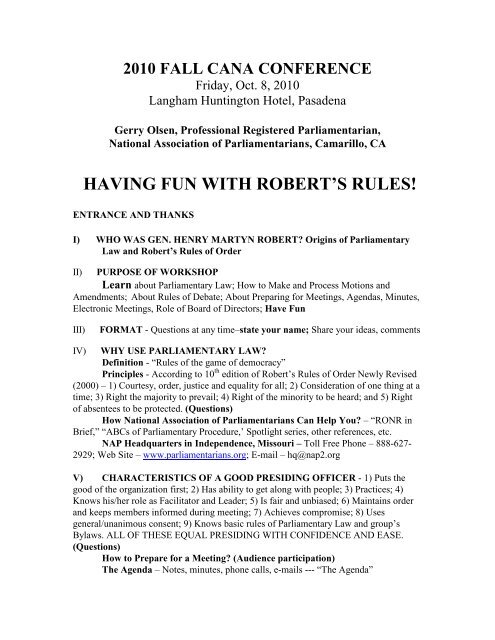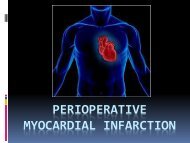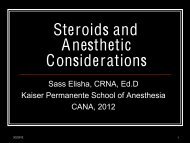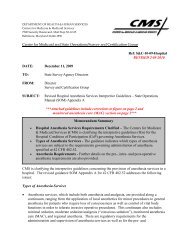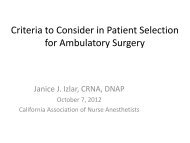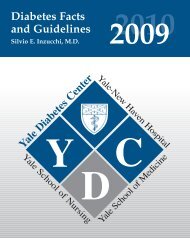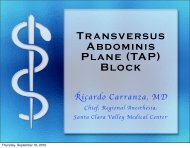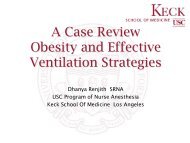having fun with robert's rules!
having fun with robert's rules!
having fun with robert's rules!
You also want an ePaper? Increase the reach of your titles
YUMPU automatically turns print PDFs into web optimized ePapers that Google loves.
2010 FALL CANA CONFERENCE<br />
Friday, Oct. 8, 2010<br />
Langham Huntington Hotel, Pasadena<br />
Gerry Olsen, Professional Registered Parliamentarian,<br />
National Association of Parliamentarians, Camarillo, CA<br />
HAVING FUN WITH ROBERT’S RULES!<br />
ENTRANCE AND THANKS<br />
I) WHO WAS GEN. HENRY MARTYN ROBERT? Origins of Parliamentary<br />
Law and Robert’s Rules of Order<br />
II) PURPOSE OF WORKSHOP<br />
Learn about Parliamentary Law; How to Make and Process Motions and<br />
Amendments; About Rules of Debate; About Preparing for Meetings, Agendas, Minutes,<br />
Electronic Meetings, Role of Board of Directors; Have Fun<br />
III)<br />
FORMAT - Questions at any time–state your name; Share your ideas, comments<br />
IV) WHY USE PARLIAMENTARY LAW?<br />
Definition - “Rules of the game of democracy”<br />
Principles - According to 10 th edition of Robert‟s Rules of Order Newly Revised<br />
(2000) – 1) Courtesy, order, justice and equality for all; 2) Consideration of one thing at a<br />
time; 3) Right the majority to prevail; 4) Right of the minority to be heard; and 5) Right<br />
of absentees to be protected. (Questions)<br />
How National Association of Parliamentarians Can Help You? – “RONR in<br />
Brief,” “ABCs of Parliamentary Procedure,‟ Spotlight series, other references, etc.<br />
NAP Headquarters in Independence, Missouri – Toll Free Phone – 888-627-<br />
2929; Web Site – www.parliamentarians.org; E-mail – hq@nap2.org<br />
V) CHARACTERISTICS OF A GOOD PRESIDING OFFICER - 1) Puts the<br />
good of the organization first; 2) Has ability to get along <strong>with</strong> people; 3) Practices; 4)<br />
Knows his/her role as Facilitator and Leader; 5) Is fair and unbiased; 6) Maintains order<br />
and keeps members informed during meeting; 7) Achieves compromise; 8) Uses<br />
general/unanimous consent; 9) Knows basic <strong>rules</strong> of Parliamentary Law and group‟s<br />
Bylaws. ALL OF THESE EQUAL PRESIDING WITH CONFIDENCE AND EASE.<br />
(Questions)<br />
How to Prepare for a Meeting? (Audience participation)<br />
The Agenda – Notes, minutes, phone calls, e-mails --- “The Agenda”
HAVING FUN WITH ROBERT’S RULES! – Page 2<br />
VI) PROCESSING A MOTION<br />
A) DEFINITION OF A MAIN MOTION - Business is brought before a<br />
group by the motion of a member. A main motion “is a formal proposal by a<br />
member, in a meeting, that the group take certain action.”<br />
KEY WORDS - “I move THAT …”.<br />
B) STEPS IN MAKING AND PROCESSING A MAIN MOTION<br />
(Audience participation)<br />
1) SEEKING RECOGNITION (By member) - “Madam<br />
President*” or “Mr. President.”<br />
2) ASSIGNING THE FLOOR (By President) - „Mary” or “John” or<br />
“Miss Garcia” or “Mr. Smith.”<br />
3) MAKING THE MOTION (By member) - “ I MOVE THAT …”<br />
4) SECOND (By another member) - “Second” or “I second the motion”<br />
(Recognition is not needed; The second means, “I want to talk about it.”)<br />
5) STATING THE MOTION (By President) - “It is moved and<br />
seconded that …”<br />
6) DEBATE (By President and then by members) - “Is there any<br />
discussion?” “Is there any debate?” And later - “Are you ready for the<br />
question?” AMENDMENTS MAY BE MADE HERE.<br />
7) PUTTING THE QUESTION/TAKING THE VOTE (By<br />
President) “The question is on the motion that … “Those in favor, please<br />
say „aye‟, those opposed, please say „no‟.”<br />
8) ANNOUNCING THE RESULTS (in four parts) (By President)-<br />
1) “The ‟ayes‟ have it.” 2) “The motion is carried.” 3) “You have<br />
voted to ….”. 4) The next business in order is … ”.<br />
OR 1) “The “nos” have it.” 2) “The motion is lost.” 3) “You have<br />
voted not to …”. 4) “The next business in order is …”. (QUESTIONS)<br />
* - Different organizations have different titles for their presiding officer.<br />
C) RULES OF DEBATE<br />
* - Before speaking, seek and receive recognition from the Chair.<br />
- Maker of the motion may speak first to his/her motion.<br />
- All members have a right to speak/debate/vote.<br />
- All members must address remarks to the President.<br />
- You may not interrupt a speaker, except in a few instances.<br />
- Avoid personalities (use the third person - “the previous speaker”).<br />
- Remarks must be “germane” (related to merits of the question).<br />
- PREVIOUS QUESTION (Motion to end debate) - needs 2/3<br />
vote for approval. (QUESTIONS)
HAVING FUN WITH ROBERT’S RULES! – Page 3<br />
VII) AMENDMENTS (To change a motion before final adoption) - Five forms of<br />
amendments. The key word is “BY” - “I move to amend the motion BY ….”.<br />
FORMS - Strike out, insert, strike out and insert, add (at end), and substitute.<br />
EXAMPLES. (Questions)<br />
VIII) MINUTES – What are they? (The official record of the actions of your group)<br />
What goes in and what does not? See Robert‟s Rules of Order Newly Revised, pp.<br />
451-458. This section of Robert‟s includes paragraphs on Content (especially first<br />
and last paragraphs), Signatures, Form, Reading and Approval, and Publishing.<br />
(Questions)<br />
IX)<br />
ELECTRONIC MEETINGS – Meetings of the Board of Directors of non-<br />
Brown Act (California‟s Open Meeting Act) organizations may be held by<br />
telephone or teleconferencing. All Board members must be able to hear and/or see<br />
each other to participate in the meeting. Such meetings must be authorized in your<br />
Bylaws and supported by Special Rules of Order or Board Procedures. Meetings<br />
where you cannot hear and/or see each other are not authorized by Robert‟s Rules<br />
of Order Newly Revised. (Questions)<br />
X) ROLE OF A BOARD OF DIRECTORS - Keep focused on the long-range view,<br />
on overall guidance, and on RESULTS; Focus also on Bylaws, Policies, and<br />
Procedures; Say “no” to micro-management; Provide fiscal responsibility;<br />
Importance of Records; Role of an Individual Board Member; The Board “speaks‟<br />
by majority vote. (Questions)<br />
XI)<br />
CONCERNS, QUESTIONS AND FUTURE HELP - I will be glad to talk <strong>with</strong><br />
you on individual problems. I am always available at any time by phone or e-<br />
mail to help you and this organization. (Questions)<br />
XII) SUMMARY OF WORKSHOP<br />
REFERENCE: Robert’s Rules of Order Newly Revised (10 th edition,<br />
published 2000)<br />
Gerald Olsen, PRP, 861 Durkin St., Camarillo, CA 93010-4926;<br />
Cell – 805-660-7299; Phone and Fax – 805-482-4109;<br />
E-mail – gerryolsen@dock.net<br />
8/28/2010
BROWN ACT (California’s Open Meeting Act) – Meetings must be open to the<br />
public, except in a few instances; Agendas must be posted in two places 72 hours<br />
before regular meetings and 24 hours before special meetings; Time for public<br />
comments must be allowed at each meeting and time allotted in the agenda;<br />
Records of the Board are open to the public including minutes and recordings;<br />
Anything handed out in an open meeting is a public record.


